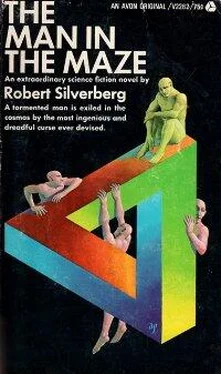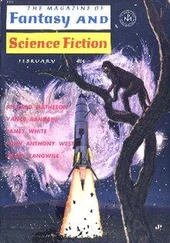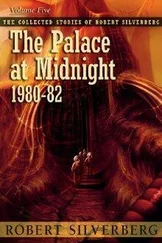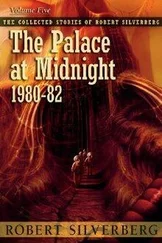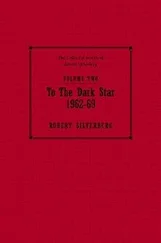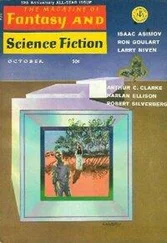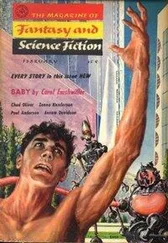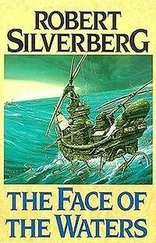At the expense of a few mole probes they found out that reaching the city through a tunnel was equally impossible. The moles burrowed into the coarse sandy soil outside the outer walls, chewed themselves passageways fifty meters down, and nosed upward again when they were beneath the maze. They were destroyed by the safety field while still twenty meters below ground level. A try at burrowing in right at the base of the embankments also failed; the field went straight down, apparently, all around the city.
A power technician offered to rig an interference pylon to drain the energy of the field. It didn’t work. The pylon, a hundred meters tall, sucked in power from all over the planet; blue lightning leaped and hissed along its accumulator bank, but it had no effect on the safety field. They reversed the pylon and sent a million kilowatts shooting into the city, hoping to short the field. The field drank everything and seemed ready for more. No one had any rational theory to explain the field’s power source. “It must tap the planet’s own energy of rotation,” the technician who had rigged the pylon said, and then, realizing he hadn’t contributed anything useful, he looked away and began to snap orders into the hand-mike he carried.
Three days of similar researches demonstrated that the city was invulnerable to intrusion from above or below.
“There’s only one way in,” said Hosteen, “and that’s on foot, through the main gate.”
“If the people in the city really wanted to be safe,” Rawlins asked, “why did they leave even a gate open?”
“Maybe they wanted to go in and out themselves, Ned,” said Boardman quietly. “Or maybe they wanted to give invaders a sporting chance. Hosteen, shall we send some probes inside?”
The morning was gray. Clouds the color of wood smoke stained the sky; it looked almost as if rain were on the way. A harsh wind knifed the soil from the plain and sent it slicing into their faces. Behind the veil of clouds lay the sun, a flat orange disk that seemed to have been pasted into the sky. It seemed only slightly larger than Sol as seen from Earth, though it was less than half as distant. Lemnos’ sun was a gloomy M dwarf, cool and weary, an old star circled by a dozen old planets. Lemnos, the innermost, was the only one that had ever sustained life; the others were frigid and dead, beyond the range of the sun’s feeble rays, frozen from core to atmosphere. It was a sleepy system with so little angular momentum that even the innermost planet dawdled along in a thirty-month orbit; the three zippy moons of Lemnos, darting on crisscrossing tracks a few thousand kilometers overhead, were flagrantly out of keeping with the prevailing mood of these worlds.
Ned Rawlins felt a chill at his heart as he stood beside the data terminal a thousand meters from the outer embankment of the maze, watching his shipmates marshalling their probes and instruments. Not even dead pockmarked Mars had depressed him like this, for Mars was a world that had never lived at all, while here life had been and had moved onward. This world was a house of the dead. In Thebes, once, he had entered the tomb of Pharaoh’s vizier, five thousand years gone, and while the others in his group had eyed the gay murals with their glowing scenes of white-garbed figures punting on the Nile, he had looked toward the cool stone floor where a dead beetle lay, clawed feet upraised on a tiny mound of dust. For him Egypt would always be that stiffened beetle in the dust; for him Lemnos was likely to be autumn winds and scoured plains and a silent city. He wondered how anyone as gifted, as full of life and energy and human warmth as Dick Muller, could ever have been willing to maroon himself inside that dismal maze.
Then he remembered what had happened to Muller on Beta Hydri IV, and conceded that even a man like Muller might very well have good reasons for coming to rest on a world like this, in a city like this. Lemnos offered the perfect escape: an Earthlike world, uninhabited, where he was almost guaranteed freedom from human company. And we’re here to flush him out and drag him away. Rawlins scowled. Dirty dirty dirty, he thought. The old thing about the ends and the means. Across the way Rawlins could see the blocky figure of Charles Boardman standing in front of the big data terminal, waving his arms this way and that to direct the men fanning out near the walls of the city. He began to understand that he had let Boardman dragoon him into a nasty adventure. The glib old devil hadn’t gone into details, back on Earth, about the exact methods by which they were going to win Muller’s cooperation. Boardman had made it sound like some kind of shining crusade. Instead it was going to be a dirty trick. Boardman never went into the details of anything before he had to, as Rawlins was beginning to see. Rule one: hoard your resources of strategy. Never tip your hand. And so here I am, part of the conspiracy.
Hosteen and Boardman had deployed a dozen drones at the various entrances to the inner part of the maze. It was already clear that the only safe way into the city was through the northeastern gate; but they had drones to spare, and they wanted all the data they could gather. The terminal Rawlins was watching flashed a partial diagram of the maze on the screen—the section immediately in front of him—and gave him a good long time to study its loops and coils, its zigzags and twists. It was his special responsibility to follow the progress of the drone through this sector. Each of the other drones was being monitored both by computer and by human observer, while Boardman and Hosteen were at the master terminal watching the progress of the entire operation all at once.
“Send them in,” Boardman said.
Hosteen gave the command, and the drones rolled forward through the city’s gates. Looking now through the eyes of the squat mobile probe, Rawlins got his first view of what lay in Zone H of the maze. He saw a scalloped wall of what looked like puckered blue porcelain undulating away to the left, and a barrier of metallic threads dangling from a thick stone slab to the other side. The drone skirted the threads, which tinkled and quivered in delicate response to the disturbance of the thin air; it moved to the base of the porcelain wall, and followed it at an inward-sloping angle for perhaps twenty meters. There the wall curved abruptly back on itself, forming a sort of chamber open at the top. The last time anyone had entered the maze this way—on the fourth expedition—two men had passed that open chamber; one had remained outside and was destroyed, the other had gone inside and was spared. The drone entered the chamber. A moment later a beam of pure red light lanced from the center of a mosaic decoration on the wall and swept over the area immediately outside the chamber.
Boardman’s voice came to Rawlins through the speaker taped to his ear. “We lost four of the probes the moment they went through their gates. That’s exactly as expected. How’s yours doing?”
“Following the plan,” said Rawlins. “So far, it’s okay.”
“You ought to lose it within six minutes of entry. What’s your elapsed time now?”
“Two minutes fifteen.”
The drone was out of the chamber now and shuttling quickly through the place where the light-beam had flashed. Rawlins keyed in olfactory and got the smell of scorched air, lots of ozone. The path divided ahead. To one side was a single-span bridge of stone, arching over what looked like a pit of flame; to the other was a jumbled pile of cyclopean blocks resting precariously edge to edge. The bridge seemed far more inviting, but the drone immediately turned away from it and began to pick its way over the jumbled blocks. Rawlins asked it why, and it relayed the information that the “bridge” wasn’t there at all; it was a projection beamed from scanners mounted beneath the facing piers. Requesting a simulation of an approach anyway, Rawlins got a picture of the probe walking out onto the pier and stepping unsuspectingly through the solid-looking bridge to lose its balance; and as the simulated probe struggled to regain its equilibrium, the pier tipped forward and shucked it into the fiery pit. Cute, Rawlins thought, and shuddered.
Читать дальше
